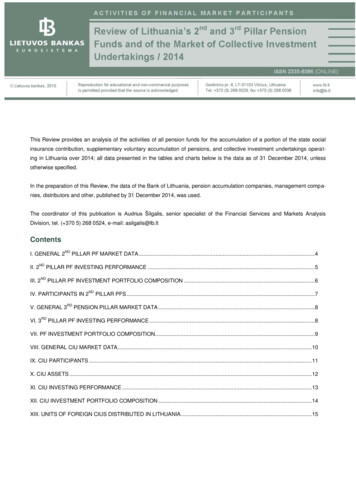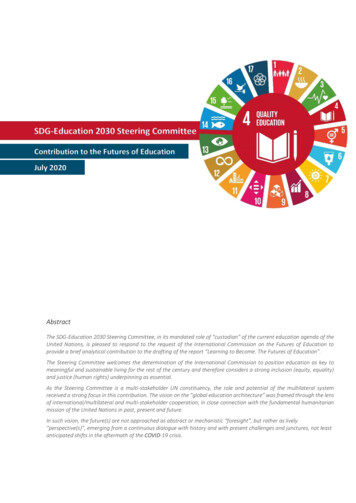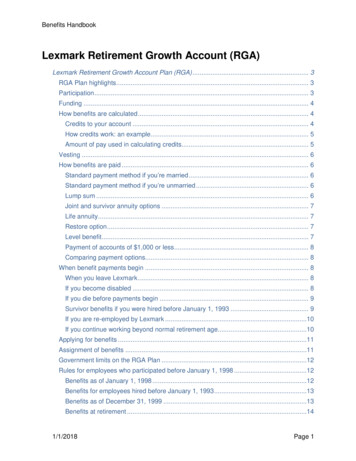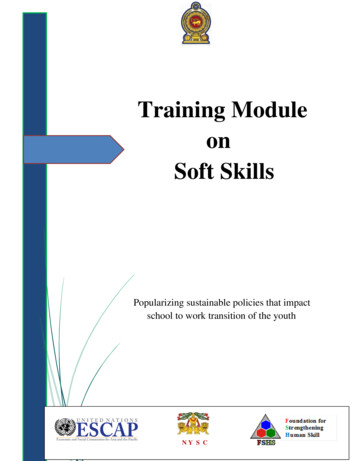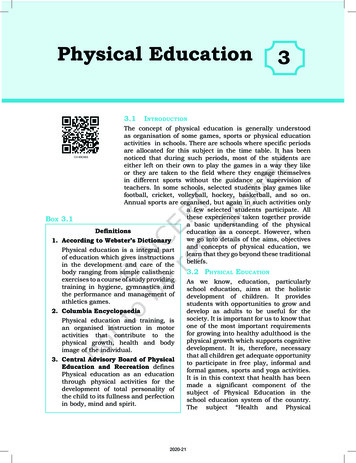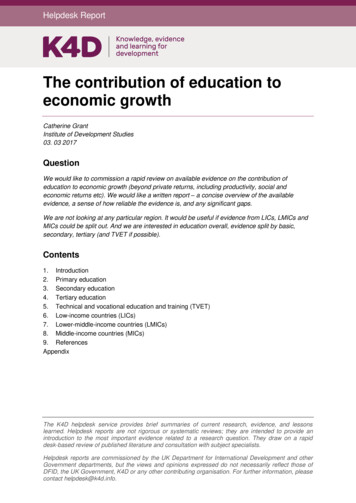
Transcription
Helpdesk ReportThe contribution of education toeconomic growthCatherine GrantInstitute of Development Studies03. 03 2017QuestionWe would like to commission a rapid review on available evidence on the contribution ofeducation to economic growth (beyond private returns, including productivity, social andeconomic returns etc). We would like a written report – a concise overview of the availableevidence, a sense of how reliable the evidence is, and any significant gaps.We are not looking at any particular region. It would be useful if evidence from LICs, LMICs andMICs could be split out. And we are interested in education overall, evidence split by basic,secondary, tertiary (and TVET if possible).Contents1. Introduction2. Primary education3. Secondary education4. Tertiary education5. Technical and vocational education and training (TVET)6. Low-income countries (LICs)7. Lower-middle-income countries (LMICs)8. Middle-income countries (MICs)9. ReferencesAppendixThe K4D helpdesk service provides brief summaries of current research, evidence, and lessonslearned. Helpdesk reports are not rigorous or systematic reviews; they are intended to provide anintroduction to the most important evidence related to a research question. They draw on a rapiddesk-based review of published literature and consultation with subject specialists.Helpdesk reports are commissioned by the UK Department for International Development and otherGovernment departments, but the views and opinions expressed do not necessarily reflect those ofDFID, the UK Government, K4D or any other contributing organisation. For further information, pleasecontact helpdesk@k4d.info.
1. IntroductionThere are many reasons why education is important, this report focuses on its contribution toeconomic growth and outcomes. Education ‘can be defined as the stock of skills, competencies,and other productivity-enhancing characteristics’ (WEF 2016). In general, education—as a criticalcomponent of a country’s human capital—increases the efficiency of each individual worker andhelps economies to move up the value chain beyond manual tasks or simple productionprocesses (WEF 2016). Human capital has long been considered the most distinctive feature ofthe economic system and further work has proven the impact of education on productivity growthempirically.The World Economic Forum 2016 suggested three channels through which education affects acountry’s productivity. First, it increases the collective ability of the workforce to carry out existingtasks more quickly. Second, secondary and tertiary education especially facilitate the transfer ofknowledge about new information, products, and technologies created by others (Barro and Lee2010). Finally, by increasing creativity it boosts a country’s own capacity to create newknowledge, products, and technologies.There is a wealth of literature on this topic, showing the long held expectation that human capitalformation (a population’s education and health status) plays a significant role in a country’seconomic development. Better education leads not only to higher individual income but is also anecessary (although not always sufficient) precondition for long-term economic growth (IIASA2008). Woessmann 2015 surveys the most recent empirical evidence stating that it shows thecrucial role of education for individual and societal prosperity.Education is a leading determinant of economic growth, employment, and earnings. Ignoring theeconomic dimension of education would endanger the prosperity of future generations, withwidespread repercussions for poverty, social exclusion, and sustainability of social securitysystems (Woessman 2015). For every US 1 spent on education, as much as US 10 to US 15can be generated in economic growth (UNESCO 2012). If 75% more 15-year-olds in forty-six ofthe world’s poorest countries were to reach the lowest OECD benchmark for mathematics,economic growth could improve by 2.1% from its baseline and 104 million people could be liftedout of extreme poverty (UNESCO 2012).What level of education is needed for economic growth?Investment in secondary education provides a clear boost to economic development, much morethan can be achieved by universal primary education alone. Hence, the focus of the UnitedNations Millennium Development Goals on universal primary education was important butinsufficient. Universal primary education must be complemented with the goal of ensuring broadsections of the population have at least completed junior secondary education (IIASA 2008). TheSustainable Development Goals (SDGs) also have education targets including that ‘by 2030,ensure that all girls and boys complete free, equitable and quality primary and secondaryeducation leading to relevant and effective learning outcomes’. This shows more of anawareness of the importance of secondary education.Only broad based secondary education and universal primary education is likely to give poorcountries the human capital boost necessary to bring large segments of the population out ofpoverty. For more industrialised countries, tertiary education of younger adults also plays a keyrole in economic growth (IIASA 2008).2
Policy implicationsFor international policymakers, more and better education should become the top prioritybecause it empowers the people to help themselves and thus helps to improve governance andto reduce corruption. A concerted effort for much more primary and secondary educationcombining national and international forces would appear to be the most promising route out ofpoverty and toward sustainable development (IIASA 2008). Policy-makers interested inadvancing future prosperity should particularly focus on educational outcomes, rather than inputsor attainment (Woessmann 2015).Other considerationsEducation concerns not only the quantity of schooling—the percentage of the population thatcompleted primary, secondary, or tertiary education—but also, critically, its quality. Hanushekand Kimko (2000), for example, find that it is not merely years of schooling but the quality ofschooling (which may be reflected in international examinations) that has a significantrelationship with economic growth. Pavlova noted in her email communication that when TheWorld Economic Forum measures secondary and tertiary enrolment rates, their measurementalso includes training and the quality of education as evaluated by business leaders and theextent of staff training (WEF 2016).The SDGs note that there has been major progress in education access, specifically at theprimary school level, for both boys and girls. However, access does not always mean quality ofeducation, or completion of primary school. Currently, 103 million youth worldwide still lack basicliteracy skills, and more than 60 per cent of them are women.Hanushek et al (2010) review the role of education in promoting economic growth, with aparticular focus on the role of educational quality. It concludes that there is strong evidence thatthe cognitive skills of the population – rather than mere school attainment – are powerfullyrelated to long-run economic growth. The relationship between skills and growth provesextremely robust in empirical applications. The effect of skills is complementary to the quality ofeconomic institutions. Growth simulations reveal that the long-run rewards to educational qualityare large but also require patience.The focus on human capital as a driver of economic growth for developing countries has led toundue attention on school attainment. Developing countries have made considerable progress inclosing the gap with developed countries in terms of school attainment, but research hasunderscored the importance of cognitive skills for economic growth. This result shifts attention toissues of school quality, where developing countries have been much less successful in closingthe gaps with developed countries. Without improving school quality, developing countries willfind it difficult to improve their long run economic performance (Hanushek et al 2010).Spending on education is becoming more of a priority worldwide. The graph below shows that amajority of countries have increased education spending as a share of national income since1999.3
Source: UNESCO (2015) Education for All 2000-2015: Achievements and Challenges. EFA Global Monitoring Report 2015.UNESCO Publishing.Beyond economic growthAdditionally, health and survival rates, fertility levels and even the quality of a country’sgovernance and institutions can plausibly be assumed to be linked to a country’s levels ofeducational attainment (IIASA 2008). While completion of a basic education is associated withhigher quality health indicators, progress on the other MDGs were influenced even more by thecompletion of a secondary education, and especially by women, for example in sub‐SaharanAfrica, an estimated 1.8 million children’s lives could have been saved in 2008 if their mothershad at least secondary education – a 41% reduction (UNESCO 2011). Women with a secondaryeducation seek out antenatal care and better medical treatment in general, take more measuresto improve their children’s health, delay marriage and have fewer children (thus reducingmaternal mortality), are more likely to send their children to school, and have greater economicopportunities that will alleviate poverty and hunger (UNESCO 2010).A note on the evidence baseThere is a large evidence base on this topic. However, understanding how education influencesa person’s future is not straightforward. For several decades, economists have measured theeffects of skills on work opportunities mainly by looking at the difference in earnings betweenpeople with different levels of education. These studies originally analysed the apparently simplerelationship between wages, years of schooling and years of experience, controlling for basicdemographic characteristics such as gender and age, to estimate the rate of return to education– the percentage increase in wages for each year of school (UNESCO 2012). The most recentcompilation of studies from around the world suggests that not only are returns to education highin general, but the return to post-primary education is higher than for primary schooling4
(Colclough et al., 2010). Yet there are wide variations in these patterns among countries. Onereason for the mixed evidence is that the number of years of education is an imperfect measureof what young people learn. Simply completing primary and lower secondary education does notnecessarily mean obtaining foundation skills. Also acquiring basic literacy and numeracy alone isnot enough to get good jobs (UNESCO 2012).GlossaryPrimary education: Primary education is typically the first stage of compulsory education,coming between early childhood education and secondary education.Secondary education: Typically takes place after six years of primary education and is followedby higher education, vocational training or employment.Tertiary education: Tertiary education, also referred to as third stage, third level, and postsecondary education, is the educational level following the completion of a school providinga secondary education. The World Bank, for example, defines tertiary education as includinguniversities as well as institutions that teach specific capacities of higher learning such ascolleges, technical training institutes, community colleges, nursing schools, researchlaboratories, centres of excellence, and distance learning centres.Technical and Vocational Education and Training (TVET): Vocational education is educationthat prepares people to work in a trade, a craft, as a technician, or in professional vocations.Craft vocations are usually based on manual or practical activities and are traditionally nonacademic but related to a specific trade or occupation.LICs, LMICs, MICs: For the current 2017 fiscal year, low-income economies are defined asthose with a GNI per capita, calculated using the World Bank Atlas method, of 1,025 or less in2015; lower middle-income economies are those with a GNI per capita between 1,026 and 4,035; upper middle-income economies are those with a GNI per capita between 4,036 and 12,475; high-income economies are those with a GNI per capita of 12,476 or more. A list ofcountries in each group is in the appendix of this report with a reference to the World Bankwebsite.2. Primary educationA considerable amount of evidence on the positive economic effects of a completed primaryeducation, especially for those working in agriculture, has been generated over the past 40 years(UNESCO 2010). A study which modelled the impact of attainment in fifty countries between1960 and 2000 found that an additional year of schooling can increase a person’s earnings by10% and average GDP by 0.37% annually (Hanushek et al., 2008). A different cross-countrystudy claimed that each additional year of education increases income by 10% (Psacharopoulosand Patrinos, 2004). Generally, economic rates of return to individuals’ and societies’ investmentin primary education have been reported to be higher in low income countries than in highincome countries and to be higher for primary education than for secondary or tertiary education(UNESCO 2010). The Commission on Growth and Development (2008) concluded that socialreturns probably exceed private returns through the broader contribution to society of educatedindividuals.5
An influential early study which analysed the effects of primary education on agriculturalproduction in 13 countries found that the average annual gain in production associated with fouryears of schooling was 8.7% (Lockheed, Jamison and Lau, 1980). A more recent paper by deMuro and Burchi (2007) examined the relationship between primary education and foodinsecurity across 48 countries. The results showed that doubling the attendance rates in primaryeducation for rural populations would reduce levels of food insecurity by between 20% and 24%.Some papers which measured the effect on income of the quality of education showed that theseare higher than previously understood (Hanushek and Wossman, 2007).The incidence of poverty across households is closely linked to educational attainment(UNESCO 2010). For example, a study found that in Papua New Guinea, people living inhouseholds headed by a person with no formal education constitute more than 50% of the poorwhile in the Republic of Serbia, the poverty level of households where the head has no schoolingis three times higher than the national average (UNDP 2010a).Basic education also impacts on poverty reduction and hunger. The feeding and body weightmonitoring provided in many early childhood programmes can directly alleviate malnutrition whileresearch based on the International Adult Literacy Survey has shown that adult literacyprogrammes can raise earnings potential at a similar rate as additional years of schooling(UNESCO 2010). The case of China has shown during the past twenty years that combatingilliteracy aggressively is possible and can provide governments with the incentive for moving theircitizens towards economic sectors with higher productivity (UNESCO 2010).Social change and long-term prospects for economic growth rely considerably on the expansionof quality learning opportunities for all. Greater equity in both education enrolment and schoolquality across all population groups will result in a more equal income distribution and reducesocioeconomic inequalities in general (UNESCO 2010).171 million people could be lifted out of poverty if all students in low‐income countries left schoolwith basic reading skills – that is equivalent to a 12% drop in the number of people living on lessthan 1.25 a day (UNESCO 2011).The expansion of basic education leads to improvements in the other areas across thepopulation in general. This is even more the case for socially and economically marginalisedgroups who have the most to gain from basic education (UNESCO 2010).3. Secondary educationInvestment in secondary education provides a clear boost to economic development, much morethan can be achieved by universal primary education alone. Hence, the focus of the UnitedNations Millennium Development Goals on universal primary education was important butinsufficient. Universal primary education must be complemented with the goal of giving broadsegments of the population at least a completed junior secondary education (IIASA 2008). ThisIIASA study claims that data deficiencies are responsible for previous research study findingswhich show that changes in educational attainment are largely unrelated to economic growth.IIASA researchers completed a full reconstruction of the education attainment distribution by ageand sex for 120 countries for the years 1970–2000. The advantages of this dataset compared toothers arise from its detail (four educational categories for five-year age groups of men andwomen), its consideration of differential mortality, and its strict consistency of the definition ofeducational categories over time. This level of detail allows researchers to perform more detailed6
statistical analyses of the relation between education and economic growth than had previouslybeen possible (Lutz et al 2007).Pavlova also cited the following evidence in her email communication when contacted for thisreport. Although official numbers are not available, indirect data shows a correlation between theenrolment rate in primary and secondary education and position of the country in theInternational Competitive Index (WEF 2016). For example, Laos is ranked 93rd, Cambodia 95thand Myanmar 125th (WEF 2016) in terms of the International Competitive Index; and enrolmentrates in secondary education are especially low in these countries (ASEAN Secretariat 2015).Additionally, the figure below shows a correlation between economic growth and secondaryenrolment levels when comparing five countries (UNESCO 2012).Source: UNESCO 20127
Make secondary education a goalIn 2000 world leaders meeting in New York announced the United Nations MillenniumDevelopment Goals (MDGs). One goal that featured prominently was that of universal primaryeducation by 2015. The SDGs, which followed on from these, also have education targetsincluding that ‘by 2030, ensure that all girls and boys complete free, equitable and quality primaryand secondary education leading to relevant and effective learning outcomes’. This shows moreof an awareness of the importance of secondary education. A majority of the 94 low and middleincome countries with information have legislated free lower secondary education since 1999. Ofthese, 66 have constitutional guarantees and 28 enacted other legal measures. As of 2015, onlya few nations charge lower secondary school fees, including Botswana, Guinea, Papua NewGuinea, South Africa and the United Republic of Tanzania (UNESCO 2016). However, 1/3 ofadolescents in low and middle income countries will not have completed lower secondary schoolin 2015 (UNESCO 2016).The graph below, showing different scenarios, highlights the benefits of complementing universalprimary education with broad based secondary education. Only this step is likely to give initiallypoor countries the human capital boost that is necessary to bring large segments of thepopulation out of poverty.More details on this study can be found in the paper, but this report wants to highlight scenario 3in this section on secondary education. Scenario 3 considers a possible new MDG effort thatadds widespread secondary education (assuming 50% of the population achieves at least somesecondary schooling) to universal primary. The model simulations indicate that this additionalinvestment in secondary education provides a huge boost to economic growth, over five times8
the level of the baseline scenario and also much more than in the scenario of universal primaryeducation alone (IIASA 2008).The data enables researchers to explore the education effects of different age and educationstructures. The findings show that there are differences in the impact of educational attainmenton economic growth across age groups. In particular, tertiary education of younger adults (2039), for instance, matters more in terms of economic growth than that of older adults, while theopposite is the case for secondary education (IIASA 2008).While primary and other components of basic education remain a priority, the direct contributionof secondary education (particularly for young women) to the achievement of the other MDGsneeds to be recognised and planned for. While completion of a basic education is associatedwith higher quality health indicators, progress on the other MDGs are influenced even more bythe completion of a secondary education, and especially by women, for example in sub‐SaharanAfrica, an estimated 1.8 million children’s lives could have been saved in 2008 if their mothershad at least secondary education – a 41% reduction (UNESCO 2011).MDG 3 called for gender parity in primary and secondary education by 2005. Women with asecondary education seek out antenatal care and better medical treatment in general, take moremeasures to improve their children’s health, delay marriage and have fewer children (thusreducing maternal mortality), are more likely to send their children to school, and have greatereconomic opportunities that will alleviate poverty and hunger (UNESCO 2010). However,another report found that the effects of completing secondary education on young people’s abilityto find adequately paid work vary by gender. In Nepal, young men who have not completedsecondary education are more likely to earn an adequate wage than better-educated youngwomen – over 40% earn above the poverty line, compared with fewer than 30% of young womenwho have completed secondary schooling (UNESCO 2012).4. Tertiary educationHEART produced a Higher Education Topic Guide which looks at the contribution of highereducation to economic growth (Power et al 2015). It states that traditionally the contribution ofeducation to economic development was analysed in terms of the relationship between the levelof education and earnings and also in the form of rates of return (A summary statistic of therelationship between lifetime earnings and the costs of education). Available estimates on thesocial and private rates of return to investment in primary education are the highest, followed bysecondary education. Returns to higher education (HE) are the least. Such evidence wasextensively used to discourage public investment in HE and to concentrate almost exclusively onprimary education in the 1980s and 1990s (Power et al 2015).Recent evidence, however, suggests that HE can produce both social and private benefits(Power et al 2015). Estimates of regional average social and private rates of return are shown inthe table below, which is from the HEART topic guide. Although there are variations in the ratesof return between several countries, commonly they show that investment in HE yields positiverates of return to the individual (19%) and society (10%) (Psacharopoulos & Patrinos, 2002).9
The HEART Topic Guide reviews a paper by Tilak. This paper found that the contribution of HEto economic development can also be measured with a simple regression equation. Using datafrom 49 countries in the Asia Pacific region, Tilak (2003) found a significant effect of HE (grossenrolment ratio and HE attainment) on the level of economic development (as measured by GDPper capita). Tilak (2003) pre-empted the argument that there only exists a correlation betweenthe two by allowing a time lag for HE to cause economic development (GDP per capita from1999 was regressed on the enrolment ratio around 1990). This suggests that action to improveHE needs to be taken now to allow time for its effect on economic development. Also, there arevery few countries with higher levels of HE being economically underdeveloped, while all theeconomically rich countries have not necessarily advanced in the development and spread ofHE.Tilak (2003) also showed that the proportion of the adult population with HE (a measure of thestock of human capital) is an important indicator of the level of development. This ‘stock’ indicatorrepresents the cumulative efforts of a country in the development of HE over the years. Thelarger the stock of the adult population with higher levels of education, the higher the potential foreconomic growth Tilak (2003).India’s rise onto the world economic stage is attributed by some to its decades-long successfulefforts to provide high-quality, technically orientated HE to a significant number of itscitizens Bloom et al. (2006). Research by Bloom et al. (2006) supports the idea that expandingHE may promote faster technological catch-up and improve a country’s ability to maximise itseconomic output. Results show that SSAs current production level is about 23% below itsproduction possibility frontier. A one-year increase in the HE stock would raise the growth rate ofGDP per capita by 0.24 percentage points and African output growth by an added 0.39percentage points in the first year. This implies that a one-year increase in HE stock may boostincomes by roughly 3 per cent after 5 years and ultimately by 12% Bloom et al. (2006).The private market benefits for individuals include better employment prospects, higher salaries,labour market flexibility and a greater ability to save and invest Psacharapoulos (2006). Publicbenefits, although less well studied, also exist and include higher productivity and output perworker, higher net tax revenue and less reliance on government financialsupport (Psacharapoulos 2006). Rates of return focusing solely on the private and publicfinancial rewards fail to encompass the broader benefits of HE manifested through10
entrepreneurship, job creation and good economic and political governance along with thepositive impacts of research on economies Pillay (2011).The complex relationships in economic development with a focus on the context in whichuniversities operate (political and socio-economic), the internal structure and dynamics of theuniversities themselves, and the interaction between national and institutional contexts haverecently been studied. Initially a review of the international literature on the relationship betweenHE and economic development was conducted by Pillay (2011). This was followed by the studyof three successful systems – Finland, South Korea and the North Carolina state in the US – thathave harnessed HE in their economic development initiatives to distil implications for Africancountries (Pillay, 2010). Common to the success of all these systems is, amongst others, the linkbetween economic and educational planning; quality public schooling; high tertiary participationrates with institutional differentiation; labour market demand; cooperation and networks; andconsensus about the importance of HE for education and development.Finally the key findings of eight African countries and universities – Botswana, Ghana, Kenya,Mauritius, Mozambique, South Africa, Tanzania and Uganda – were analysed and discussed(Cloete et. al., 2011). The following three main conclusions were drawn: There was a lack of clarity and agreement (pact) about a development model and therole of HE in economic development, at both national and university levels, in all eightcases. There was, however, an increasing awareness, particularly at government level,of the importance of universities in the global context of the knowledge economy. Research production at the eight African universities was not strong enough to enablethem to build on their traditional undergraduate teaching roles and make a sustainedcontribution to development via new knowledge production. A number of the universitieshad manageable student–staff ratios and adequately qualified staff, but inadequate fundsfor staff to engage in research. In addition, the incentive regimes did not supportknowledge production. In none of the countries in the sample was there a coordinated effort betweengovernment, external stakeholders and the university to systematically strengthen thecontribution that the university can make to development. While at each of theuniversities there were exemplary development projects that connected strongly toexternal stakeholders and strengthened the academic core, the challenge remains howto increase the number of these projects.However, Hanushek (2016) suggests that the quality of basic skills is key and that more highereducation without good basic skills does not pay. His paper states that higher education hasyielded substantial rewards to individuals in terms of individual earnings. Partly for this reason,but perhaps more for the potential impact on productivity and economic growth, governmentshave pushed for the expansion of higher education.However, once knowledge capital as measured by international mathematics and science tests istaken into account, school attainment (or years of schooling) per se is unrelated to economicgrowth. In this, adding years of university provide no greater impact than added years of earlierschooling. Higher education is important for skilled jobs but if universities start with students withstronger skills they produce better skilled workers. Looking across countries, the better engineersproduced in countries with greater knowledge capital appear to have a distinct impact on growthdifferences. Part of this lack of impact of attainment of higher education in the growth models11
Hanushek (2016) uses is probably that there are no good measures of university quality, so thatvery different outcomes are treated the same. But the achievement levels of students at anearlier age appears to provide an index of the aggregate skills of the students at the end of theirschooling when each level of schooling builds on earlier knowledge.Teles et al (2004) reached the
can be generated in economic growth (UNESCO 2012). If 75% more 15-year-olds in forty-six of the world’s poorest countries were to reach the lowest OECD benchmark for mathematics, economic growth could improve by 2.1% from its baseline and 104 million peo

